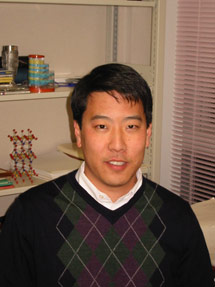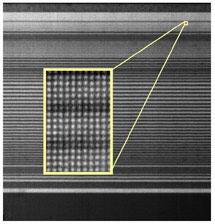
Handy Links
SLAC News Center
SLAC Today
- Subscribe
- Archives: Feb 2006-May 20, 2011
- Archives: May 23, 2011 and later
- Submit Feedback or Story Ideas
- About SLAC Today
SLAC News
Lab News
- Interactions
- Lightsources.org
- ILC NewsLine
- Int'l Science Grid This Week
- Fermilab Today
- Berkeley Lab News
- @brookhaven TODAY
- DOE Pulse
- CERN Courier
- DESY inForm
- US / LHC
SLAC Links
- Emergency
- Safety
- Policy Repository
- Site Entry Form

- Site Maps
- M & O Review
- Computing Status & Calendar
- SLAC Colloquium
- SLACspeak
- SLACspace
- SLAC Logo
- Café Menu
- Flea Market
- Web E-mail
- Marguerite Shuttle
- Discount Commuter Passes
-
Award Reporting Form
- SPIRES
- SciDoc
- Activity Groups
- Library
Stanford
Around the Bay
People: Harold Hwang Excels with Interfaces
Basic research into the properties of materials seems to cover a variety of highly technical subjects, such as high-temperature superconductivity, quantum effects, spintronics and catalytic behaviors, for example. Actually, all these areas of research boil down to one thing: control. Control of electron interactions. Control of materials synthesis. Control of emergent properties, or what happens when two very complex materials meet. The Office of Basic Energy Sciences, a part of the Department of Energy that supports fundamental research, has even identified five "grand challenges" for basic energy sciences that will lead, according to a BES report, to a "science of control."
Harold Hwang of the Stanford Institute of Materials and Energy Sciences, a joint SLAC-Stanford institute, may not be master of matter—yet—but he's learning to be very persuasive. Hwang researches "complex oxides"— materials that share similar crystal structures, but exhibit a broad range of properties. Complex oxides can act as insulators, semiconductors, metals and superconductors, to name only a few possibilities. Hwang and his group focus on fabricating crystals from extremely thin layers of these oxides, in the hopes that the crystals can be persuaded to retain the properties of the individual oxides. Either that, or new properties will arise due to interactions between the oxide layers.
Such layers are known as thin films and are vital to the semiconductor industry. After all, a silicon wafer alone does not make an integrated circuit; various other materials must be deposited on the silicon to create transistors, capacitors and so on. Are thin film complex oxides merely a means to extend Moore's Law, the maxim that computer processors double in capacity every two years?
Not quite.
"I'd like to funnel the research into something that would eventually show up in your camera or computer," Hwang admitted. "But the point is, compared to semiconductors, the additional complexity of the materials we're studying gives a much richer base of physical properties." These properties all appear in "a common family of materials that fit nicely on top of each other," Hwang said—materials which, thanks to their common crystalline structure, lend themselves to layering.
"If everything works wonderfully," he continued, "I can give you any flavor or ingredient and we can imagine stacking them together." And when Hwang says "stacking," he doesn't mean pancakes. Or even pieces of paper. Hwang's research involves depositing layers of oxide that are mere atoms thick, but remarkably, he said, the layers are quite stable.
"This really allows you to create new crystal structures," Hwang said. "The challenge going forward is to understand the design principles so we can engineer new materials for electronics, sensing, and energy applications."
Hwang is a recent transplant from the University of Tokyo. What brought him to Stanford and SLAC?
"A mix of all sorts of things," he explained. "For my subfield, Stanford is quite famous for doing this kind of interdisciplinary materials physics work very well. There's a fantastic tradition of doing the style of research that I like, which is very collaborative. I was also really excited about the opportunities at SLAC." One opportunity Hwang mentioned is the Linac Coherent Light Source.
"There are unique probes at SLAC that will allow us to study the dynamics of electrons in these systems," he explained. "We're very excited about that. A really important opportunity here is to try to intimately integrate our research at Stanford with some of SLAC's capabilities."
Hwang also emphasized the opportunity to join SIMES during a period of expansion, while the direction of the institute is being set.
"I think all the signs are excellent" for the future of SIMES, Hwang said. "There are other national labs that have big materials divisions with 300 people. Here it's more like a green field where there's a core group of people who are just fantastic. Now there's a mandate to really blossom this over the next decade."
According to Simes Director ZX Shen, Hwang himself is part of that mandate, with a knack for fostering collaborations. As his Stanford biography mentions, he's also the recipient of several awards, including the 2004 Mitsubishi Foundation Award, the 2005 Materials Research Society Outstanding Young Investigator Award, the 2007 TEPCO Foundation Award and the 2008 IBM Japan Science Prize for Physics. "Harold will contribute breadth and substantive synthesis capability to SIMES. He's a key addition."
—Lori Ann White
SLAC Today, October 6, 2010

